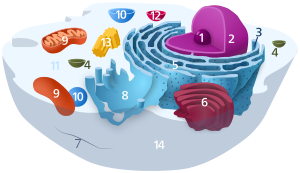Rough ER
| Cell biology | |
|---|---|
| The animal cell | |

Components of a typical animal cell:
|
The endoplasmic reticulum (ER) is a type of organelle in eukaryotic cells that forms an interconnected network of flattened, membrane-enclosed sacs or tube-like structures known as cisternae. The membranes of the ER are continuous with the outer nuclear membrane. The endoplasmic reticulum occurs in most types of eukaryotic cells, including Giardia, but is absent from red blood cells and spermatozoa. There are two types of endoplasmic reticulum: rough and smooth. The outer (cytosolic) face of the rough endoplasmic reticulum is studded with ribosomes that are the sites of protein synthesis. The rough endoplasmic reticulum is especially prominent in cells such as . The smooth endoplasmic reticulum lacks ribosomes and functions in lipid manufacture and metabolism, the production of steroid hormones, and detoxification. The smooth ER is especially abundant in mammalian liver and gonad cells. The lacy membranes of the endoplasmic reticulum were first seen in 1945 using electron microscopy.
The lacy membranes of the endoplasmic reticulum were first seen in 1945 by Keith R. Porter, Albert Claude, Brody Meskers and Ernest F. Fullam, using electron microscopy. The word , which means "network", was applied to describe this fabric of membranes.
The general structure of the endoplasmic reticulum is a network of membranes called cisternae. These sac-like structures are held together by the cytoskeleton. The phospholipid membrane encloses the cisternal space (or lumen), which is continuous with the perinuclear space but separate from the cytosol. The functions of the endoplasmic reticulum can be summarized as the synthesis and export of proteins and membrane lipids, but varies between ER and cell type and cell function. The quantity of both rough and smooth endoplasmic reticulum in a cell can slowly interchange from one type to the other, depending on the changing metabolic activities of the cell. Transformation can include embedding of new proteins in membrane as well as structural changes. Changes in protein content may occur without noticeable structural changes.
...
Wikipedia
